While working in my previous restaurant, I witnessed the magic of beef rendang firsthand. It was one of our most popular dishes, often paired with fluffy nasi lemak, and it became a staple on our menu.
Few dishes can truly elevate the senses, like beef rendang. It isn’t just a feast; it’s a symphony of flavors that captivate the taste buds.
Today, I want to share the recipe we cherished in our kitchen—one that may require a bit of effort but delivers an unforgettable flavor. Join me as we unveil the making of this exceptional dish!
Note: CNN announced the list of 50 most delicious foods 2011, and rendang took the top spot.
Note: This post may contain affiliate links. Please read my privacy policy for more info. I may receive commissions for purchases made through links in this post. As an Amazon Associate, I earn from qualifying purchases.
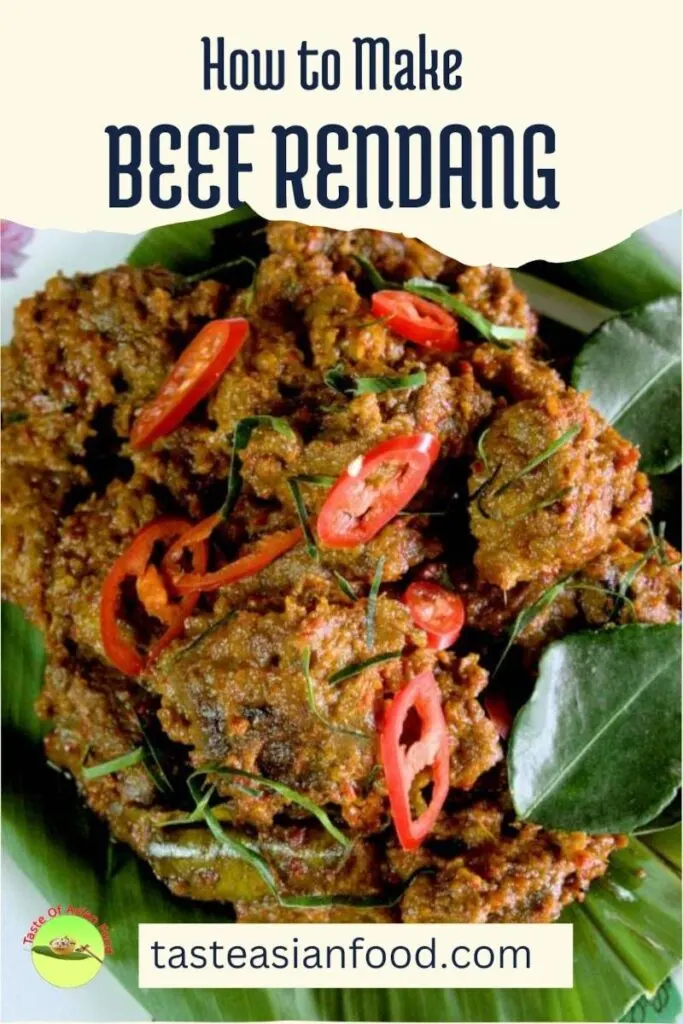
The main ingredients required to prepare beef rendang
Beef Rendang is a delicious dish that originates from West Sumatra. Our version may incorporate certain Malaysian culinary influences. Most Malaysian beef rendang recipes will include all or part of the following ingredients:
- Beef. Sirloin is best for rendang, but topside, beef chuck or any tough cuts of beef are as good since the meat is stewed for a few hours.
- Coconut cream. The best option is freshly pressed coconut cream; if unavailable, you can also use canned or tetra-packed coconut cream. Make sure to choose coconut cream suitable for cooking, as it is often confused with coconut milk, which is meant for drinking. The confusion is due to some manufacturers labeling their packaged coconut cream as coconut milk.
- Candlenuts. Candlenuts are used to thicken the gravy in rendang. They are widely available in Asia, but if not, macadamia nuts can be used as a substitute.
- Onion, ginger, galangal, turmeric. These few ingredients form the essential flavor base for rendang. Onions, in particular, provide the body of the gravy. Galangal, while resembling ginger, has a distinct flavor of its own. I understand it can be challenging to find galangal in certain places, especially outside of Asia, but it’s worth the effort, as the rendang will lack some of its intended flavor without it. If you can’t find fresh turmeric, consider using turmeric powder as an alternative.
- Cardamom pods, cumin seeds. These spices are commonly found in most countries.
- Chili. I use the local red chili (Serrano chili). If you prefer a less spicy rendang, please remove the seeds and pith before using them to make the paste. A reader once mentioned that the amount of chili was way too much. I guess he might have used other types of chili, such as bird’s eye chili!
- Lemongrass. Use only the pale yellow bulbous bottom part of the lemongrass. The greenish upper part of the stalk is fibery and should be discarded. Bash the lemongrass before use to release its flavor into the gravy more efficiently.
- Assam Keping. Assam keping (also called Assam Kandis / gelugur in Indonesia) is available in dry pieces and is quite sour. You can use tamarind pulp (assam jawa) as a replacement.
- Sugar. To balance the sourness, you need to add some sugar. Palm sugar is the best, but you can also use regular or brown sugar.
- Turmeric leaves, kaffir lime leaves. These leaves enhance the flavor of the rendang. We are fortunate to live in the part of the world where they are readily available, making the rendang more authentic.

Steps to cook beef rendang
1. Cut the beef into 4 cm squares. Avoid cutting the beef too small, as it can break into smaller pieces during cooking. Make sure to cut it against the grain using the sharpest knife available. If the beef is too soft to cut, return it to the freezer until it firms up. The pieces should not be smaller than 2 cm cubes; otherwise, the meat may easily break apart.

2. For Ingredients B in the recipe, chop all the larger items. Most of these spices can be found in Asian markets. If whole spices are unavailable, you can use ground spices, but check the expiration date to ensure you have the freshest ones for rendang. Blend until it becomes a fine paste.
Blend the spices using an electric blender without adding water, as the chilies and onions contain enough moisture. Adding water will prolong the sautéing time for the spices to turn aromatic.
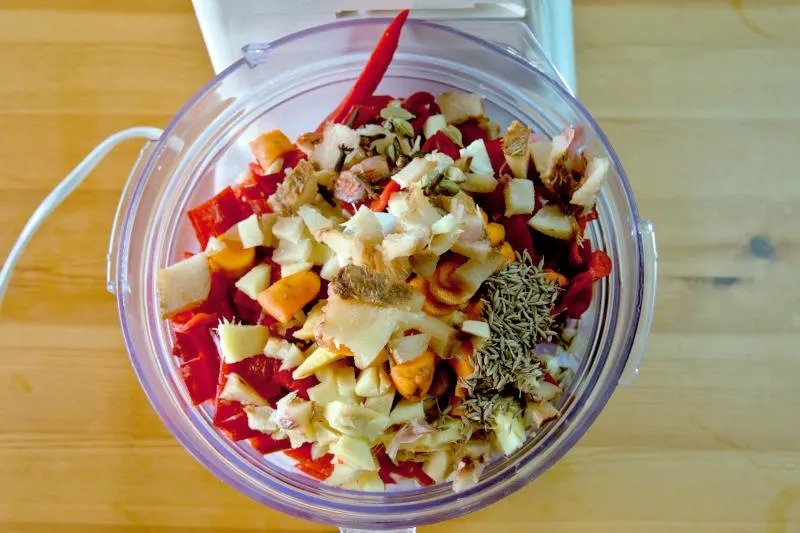
3. Heat the vegetable oil in a wok. Sauté the spice paste (blended with Ingredients B) over low to medium heat until it becomes aromatic. This step allows their flavors to develop. Stir the spice paste constantly, as it can scorch easily. Stop sautéing when the paste is fragrant or when the oil separates from the spices.
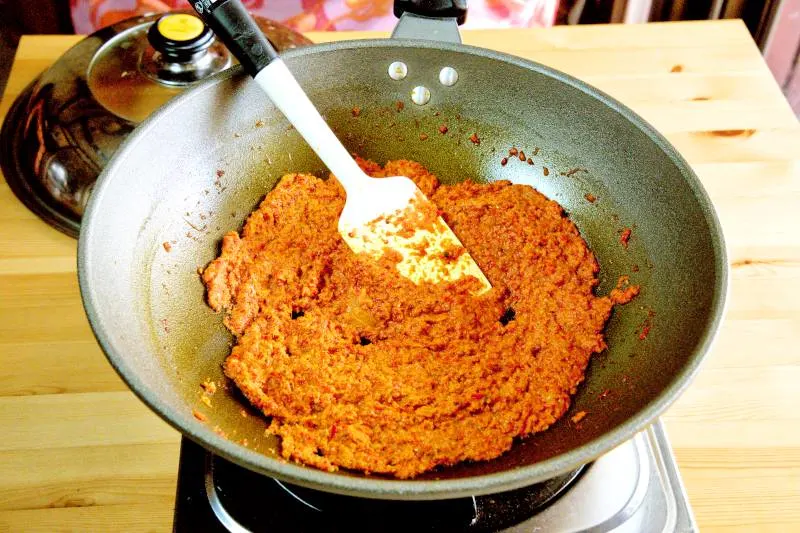
4. Add the beef and mix well with the spices. Mix with spice paste thoroughly.
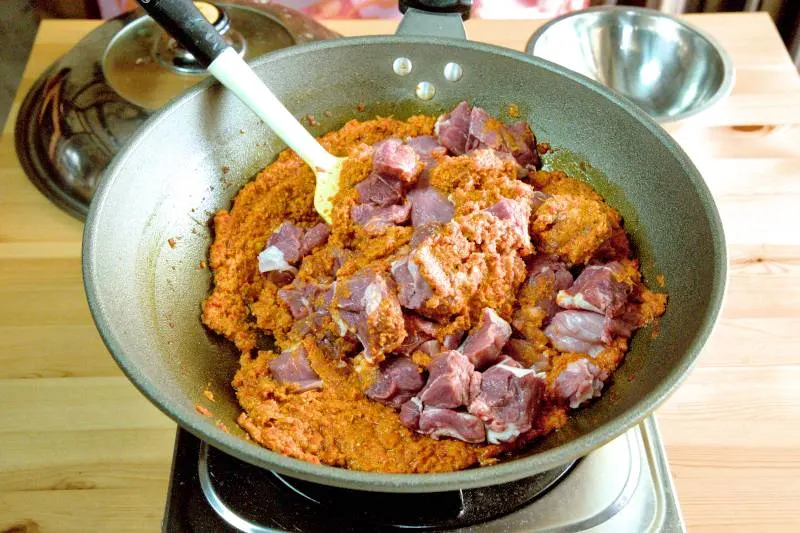
5. Add the coconut cream and some hot water to the curry paste in the wok.
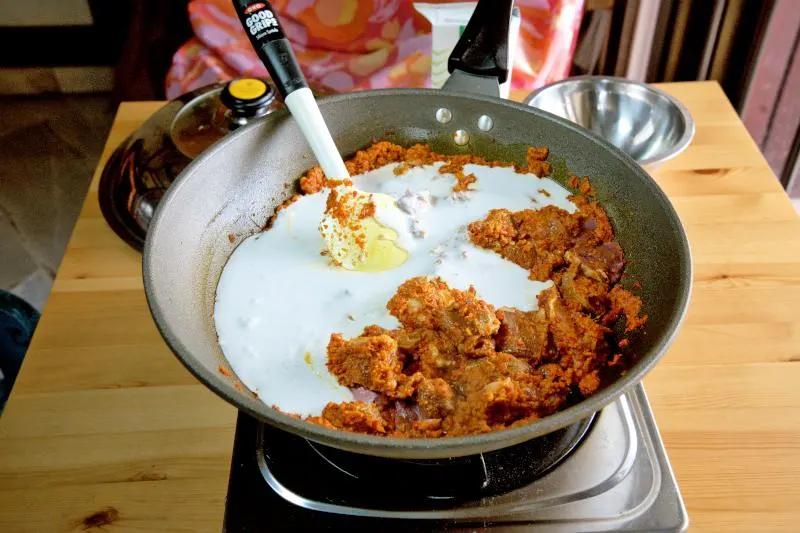
6. Prepare the lemongrass by bashing it to release its flavor. First, remove the green sections and the outer sheath, using only the white part of the lemongrass. Add the lemongrass, kaffir lime leaves, asam keping, and turmeric leaves (Ingredients C).
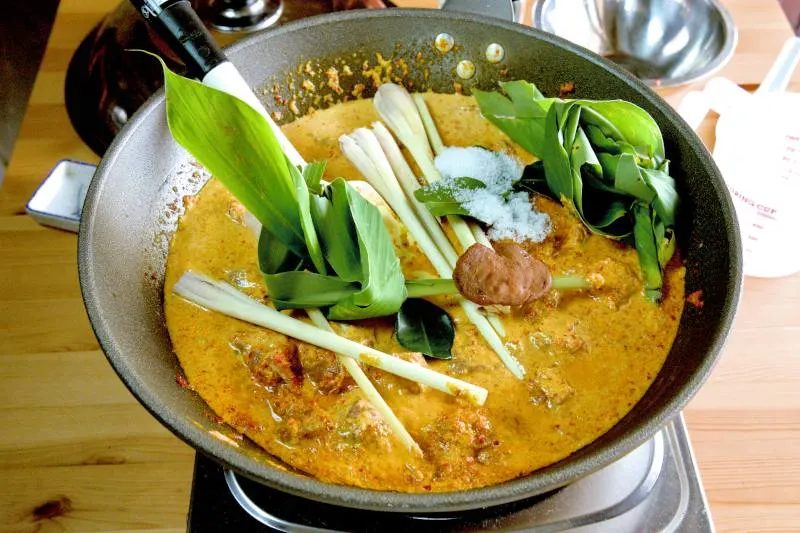
7. Once the liquid reaches a boil, reduce the heat to low and continue simmering. When the stew starts to dry out, add water as needed.
Continue cooking over low heat until the beef is tender and turns dark brown about three hours. Slow cooking is essential for achieving tender beef. You can use an Instant Pot or multicooker to shorten the cooking time. Most modern multicookers have programmed modes for beef stew. If you pressure cook the beef, remember to use less water.
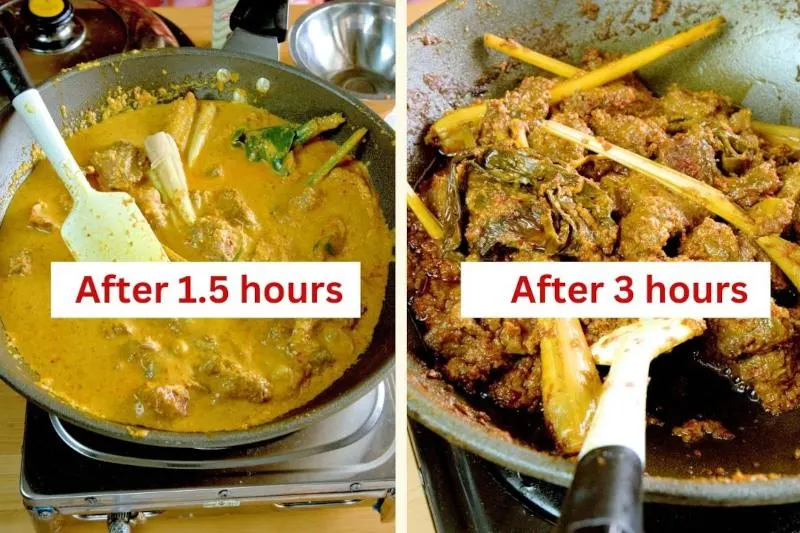
8. Since this is a dry beef rendang recipe, the cooking process should continue until the liquid is completely dry. If it becomes too dry before the cooking time ends, add water. Authentic Minang rendang is dry in texture. As the liquid evaporates, it will eventually caramelize completely. The beef will continue to cook in the remaining oil and absorb all the flavors of the spices.
Garnish the rendang with turmeric leaves cut into thin strips, red chilies, and kaffir lime leaves.
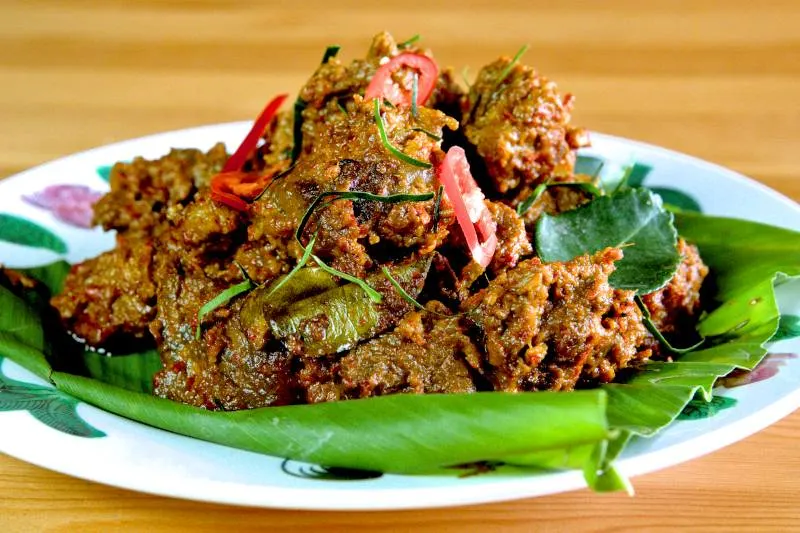
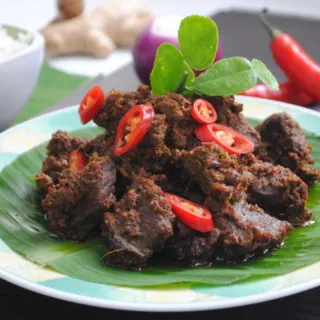
Beef Rendang Recipe
This beef rendang recipe is one of the most popular recipes in our previous restaurant. I has been use for more than 20 years.
Ingredients
Ingredients (A)
- 1 kg beef
- 600 ml coconut cream
- 100 ml vegetable oil
- Sufficient water to cook the beef
- 1 tbsp salt
- 1 tsp sugar
Ingredients (B)- to blend
- 4 candlenuts
- 12 cloves chopped garlic
- 300 g red chili, , (Serrano chili/pepper)
- 250 g onions
- 50 g ginger
- 50 g galangal
- 25 g ground turmeric, or 50g of fresh turmeric
- 1½ tsp ground coriander
- 4 green cardamom pods
- 11/2 tsp cumin seeds
- 10 cloves
Ingredients (C)- Seasonings and Spices
- 4 stalks of lemongrass, bashed
- 3 pieces kaffir lime leaves
- 1 piece asam keping
- 2 turmeric leaves, tied up
Instructions
- Cut the beef into 4 cm squares. Avoid cutting the beef too small, as it can break into smaller pieces during cooking.
- For Ingredients B in the recipe, chop all the larger items.
- Blend the spices using an electric blender without adding water.
- Heat the vegetable oil in a wok. Sauté the spice paste (blended with Ingredients B) over low heat until it becomes aromatic. Stir the spice paste constantly, as it can scorch easily. Stop sautéing when the paste is fragrant or when the oil separates from the spices.
- Add the beef and mix well with the spices.
- Prepare the lemongrass by bashing it to release its flavor.
- Add the lemongrass, kaffir lime leaves, asam keping, and turmeric leaves (Ingredients C).
- Once the liquid reaches a boil, reduce the heat to low and continue simmering. When the stew starts to dry out, add water as needed.
- Continue cooking over low heat until the beef is tender and turns dark brown, about three hours.
- Garnish the rendang with turmeric leaves cut into thin strips, red chilies, and kaffir lime leaves.
Notes
Note: Since not everyone tolerates the same level of hotness of chili, please reduce the amount and remove the seeds of the chilies if you are not used to spicy food.
Recommended Products
As an Amazon Associate and member of other affiliate programs, I earn from qualifying purchases.
-
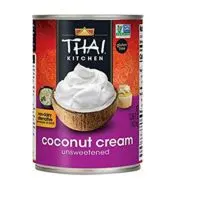 Thai Kitchen Gluten Free Coconut Cream, 13.66 fl oz
Thai Kitchen Gluten Free Coconut Cream, 13.66 fl oz -
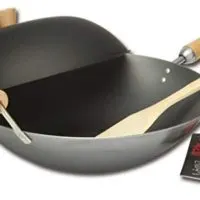 Joyce Chen 21-9972, Classic Series Carbon Steel Wok Set, 4-Piece, 14-Inch, Charcoal
Joyce Chen 21-9972, Classic Series Carbon Steel Wok Set, 4-Piece, 14-Inch, Charcoal -
 Thai Fresh galangal - 14 oz
Thai Fresh galangal - 14 oz -
 AccuWeight 207 Digital Kitchen Multifunction Food Scale for Cooking with Large Back-lit LCD Display,Easy to Clean with Precision Measuring,Tempered Glass, 0, Silver
AccuWeight 207 Digital Kitchen Multifunction Food Scale for Cooking with Large Back-lit LCD Display,Easy to Clean with Precision Measuring,Tempered Glass, 0, Silver
Nutrition Information:
Yield: 5 Serving Size: 1Amount Per Serving: Calories: 1623Total Fat: 97gSaturated Fat: 43gTrans Fat: 2gUnsaturated Fat: 49gCholesterol: 189mgSodium: 1609mgCarbohydrates: 133gFiber: 11gSugar: 87gProtein: 66g
This data was provided and calculated by Nutritionix on 12/23/2024
More tips to make the best beef rendang
- Most Asians cook rendang in a wok. If you don’t have a wok, try to find a pan with a curved bottom.
- I prefer to remove the seeds and pith of the chilies to reduce their heat. Rendang is not a very hot dish, so adjust the amount of chili to suit your taste.
- Once opened, coconut milk should be stored in the refrigerator. You can divide it into smaller portions and freeze them, as fresh coconut milk can last much longer. I have used frozen coconut milk for making rendang, and it works just as well as freshly pressed coconut cream, even after a month.
- If you do not have fresh spices, substitute ground powder for fresh coriander seeds, turmeric, and cumin seeds. This will not significantly affect the dish’s final flavor.
- Bashing the lemongrass before adding it to the coconut milk helps release its aromatic flavor into the rendang.
- Some recipes include star anise and cinnamon stick as part of the spices.
- I understand that Asam Keping may not be available in some places. You can omit it or use tamarind paste if you can’t get it. Some traditional rendang recipes from Indonesia do not include Asam Keping. However, be careful not to add too much, as rendang shouldn’t be overly sour. You can add lime juice or vinegar just before serving for a slightly tangy flavor, but it can compromise the authenticity of rendang.
- Turmeric leaves can also be difficult to find in certain parts of the world. If you can’t get turmeric leaves, you can replace them with more kaffir lime leaves.
- After stewing the beef for two hours or until it becomes quite dry, please stir more frequently, as the rendang paste tends to stick to the bottom and can burn easily.
- The beef rendang tastes better the next day after it has been kept in the refrigerator overnight after the spices penetrate and flavor the beef deeply.
Other rendang recipes for you
There are two major types of beef rendang, depending on how much water content is in the dish.
- Dried beef rendang: According to the Minangkabau (hence the name Minang rendang) tradition, their authentic beef rendang is a slow-cooked dry curry. It is stirred, simmered, and cooked for a few hours until the coconut milk has evaporated and reduced to become a thick sauce. By then, the meat had absorbed the flavor of the herbs and spices. Dried rendang can be stored at room temperature for three to four weeks. It can even last up to six months if frozen.
- Moist beef rendang (Kalio). Moist beef rendang is cooked much shorter than dry beef rendang. The cooking process ends when the coconut milk becomes a thick rendang gravy. Moist rendang is more popular in neighboring countries- Malaysia, Singapore, Brunei, and southern Thailand. One of the exceptions is rendang Tok, which is found in the state of Perak, Malaysia, and is dry. Most rendang served in Western countries is moist rendang, compared to its original Minang counterpart. Malaysian rendang is usually cooked for shorter periods and added with kerisik (toasted grated coconut) to thicken the gravy.
What to serve with rendang
Beef rendang is best eaten with steamed rice and condiments such as fried onions and chili.
It has also become a common Malaysian dish, popular during major festivals such as Eid al-Fitr. In our previous restaurant, we served it as a standalone dish that customers could order to pair with rice or noodles.
Other recipes
If you like this authentic beef rendang recipe, I want to suggest other popular Asian dishes for you to try. So here are my picks of some of the most popular recipes from where I live, Malaysia:
- Chicken Rendang. I have the Chicken rendang recipe for you if you do not eat beef. (it is the type of rendang with gravy!)
- Chicken varuval. Ready to take a bite of the intense flavor of Indian cuisine? This recipe is popular in Malaysia and loved by everyone!
- Mee Goreng is another great street food of Indian Muslim origin in Malaysia. It is authentically Malaysian and is the typical Indian Malaysian food.
- Wonton soup and noodles. We have our version of wonton noodles, which differs from the wonton soup noodles in Hong Kong. This article provides both recipes.
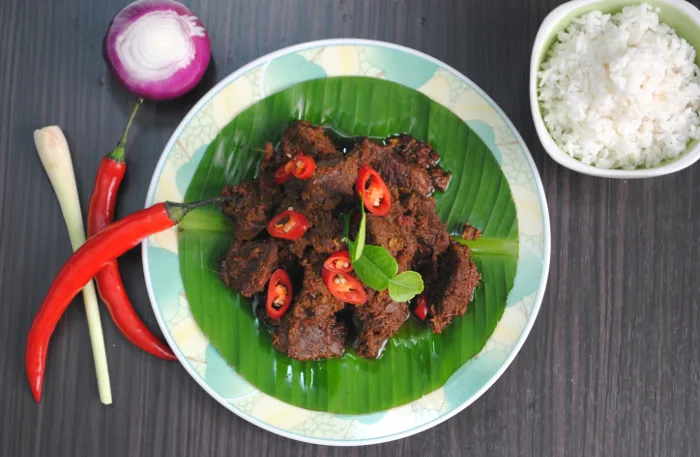
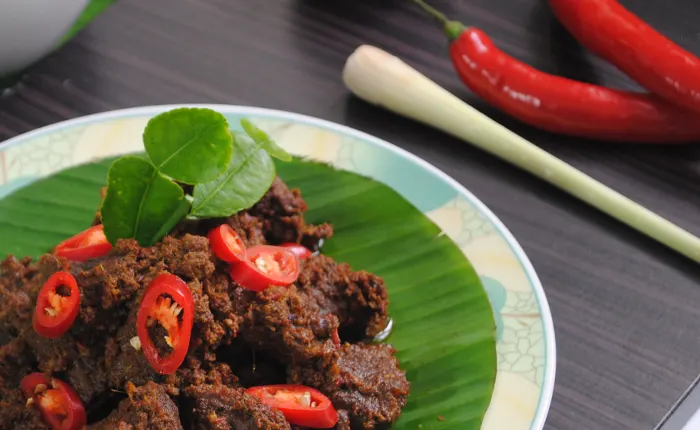

Beef and mushrooms stir-fry Chinese style (quick and easy)
Tuesday 16th of September 2025
[…] Beef rendang. This recipe was written a few years ago and remains the most popular recipe on this blog. It is an authentic Indonesian-style recipe. […]
28 Curry Recipes - Easy Indian, Thai, Japanese & More Ideas - Foodiosity
Tuesday 19th of August 2025
[…] Check this recipe. […]
Abdul
Saturday 14th of December 2024
Hi KP, I'm well into my 70s and I remember back in the 1950s and early 60s when my parents cooked any Malay or Indonesian food, they invariably put in some roasted belacan (shrimp paste to those in the western world). Do you think it advisable to add this to the minang rendang recipe? I am currently living in Toronto, Canada.
Abdul
Thursday 19th of December 2024
@KP Kwan, Thanks for your reply. In fact I have tried your minang rendang recipe 3 or 4 times already and even my hiking friends love it. I am going to try adding belacan to it next time I cook it and will let you know whether it tastes good .
Abdul
Thursday 19th of December 2024
@KP Kwan,
KP Kwan
Wednesday 18th of December 2024
I do not use belacan in this recipe, but it is okay to include it if you prefer. I believe this recipe works well either with or without belacan. If you are interested, I also have another curry recipe called Chicken Kapitan, which includes belacan. Here is the link: https://tasteasianfood.com/kapitan-chicken/
Beef Masala- Best Easy Indian Curry Recipe
Tuesday 3rd of December 2024
[…] Beef Rendang: This dish was the top seller on the menu at our former restaurant. It boasts a rich and deep savory flavor derived from the aromatic spices. […]
Rendang Tok - how to make the best beef rendang (irrestible flavor)
Sunday 10th of November 2024
[…] Beef Minang is originated from Minangkabau in Indonesia. It is perhaps the most popular rendang worldwide. […]